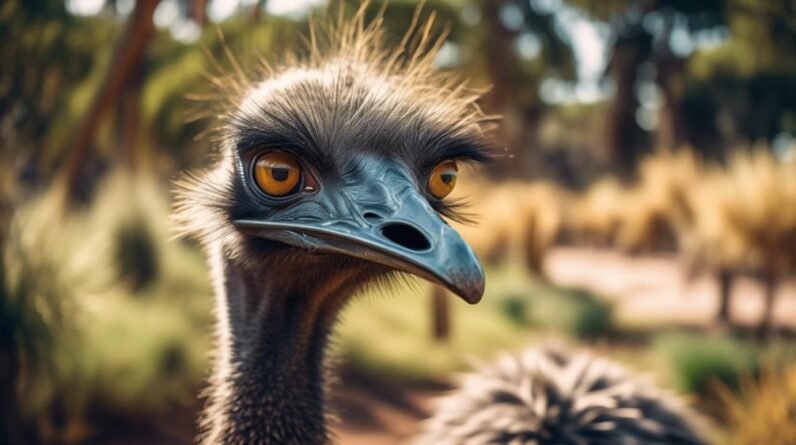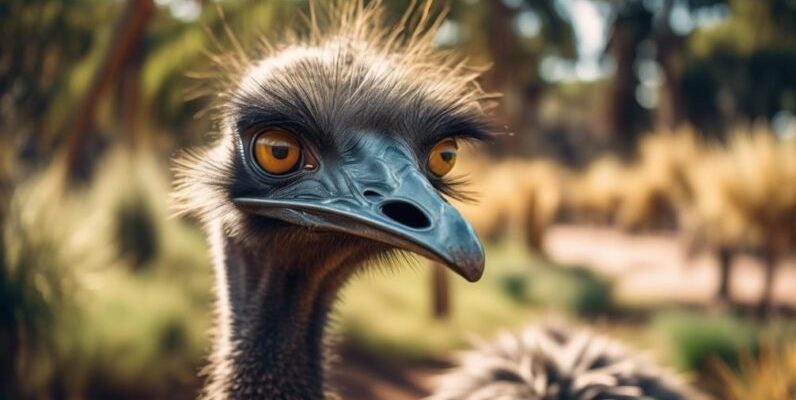
Imagine sitting down for a chat about the emu over a cup of coffee. You might say, “So, how did this big, feathered creature come to be?” Well, just like a family tree, the emu’s history stretches back millions of years and is intertwined with various species, migrations, and evolutions that are remarkable and sometimes unexpected. Let’s dive into the story of the emu and uncover the journey this interesting bird has taken through time.
Origins of the Emu: A Look Back in Time
The story of the emu begins millions of years ago, during a time when Australia was a vastly different place. Modern birds are descendants of a group called theropods, which includes famous dinosaurs like T. rex. This lineage can be traced back to the late Cretaceous period, around 66 million years ago. Fast forward to about 30 million years ago, and a distinctive lineage of large, flightless birds began to emerge on the Australian continent, known as the *ratites*. This group includes not just the emu, but also ostriches, kiwis, and cassowaries.
These birds evolved in isolation on the Australian continent. As the landscape changed, the emu adapted to various habitats, from woodlands to grasslands. At this point, you might be wondering how these birds could thrive without flying. Well, their strong legs became a significant advantage, allowing them to run fast and escape predators. It’s like being a race car in a world full of slower vehicles.
Emu’s Close Cousins: The Ratite Family
The emu isn’t alone on its evolutionary journey; it has some fascinating cousins within the ratite family. Each species has a unique connection, showing us how they have adapted to their specific environments. For instance, the ostrich, found in Africa, is the largest living bird and has evolved to thrive in the open savanna, using its speed to escape threats.
Let’s not forget the kiwi, a small flightless bird from New Zealand. Kiwis have developed a keen sense of smell to help them forage for insects and worms in the ground, unlike the emu, which relies more on vision. This diversity among ratites highlights how different environments can shape the evolution of similar species in unique ways.
Here’s a quick look at some of the significant ratite species and their characteristics:
- Ostrich: Largest bird, native to Africa, capable of running up to 45 mph.
- Kiwi: Small, nocturnal, and flightless, found in New Zealand.
- Cassowary: Known for its striking blue and black plumage and powerful legs, native to New Guinea.
The Emu and the Aboriginal Peoples
The emu holds a significant place in the culture and traditions of Australia’s Aboriginal peoples. For thousands of years, they have coexisted with this bird, utilizing its resources for food and cultural practices. Emus are depicted in Aboriginal art and stories, showcasing their importance beyond just wildlife.
One interesting aspect of Aboriginal culture is the practice of emu hunting. It’s not just about survival; it’s deeply linked to their respect for the land and its inhabitants. They understood the emu’s behaviors and habitats, developing techniques for hunting that didn’t over-exploit the population, ensuring a sustainable relationship with this majestic bird.
You might see emus featured in various ceremonies, symbolizing resilience and strength. This showcases the beautiful connection between nature and culture, demonstrating how the emu is more than just a bird—it’s a part of a living history.
Adaptations That Helped Emus Survive
Now, let’s talk about some of the remarkable adaptations that have allowed emus to thrive in Australia’s diverse environments. They’re built like natural athletes, with powerful legs that enable them to run at speeds of up to 30 miles per hour. This speed is crucial for escaping predators, especially when they’re young and vulnerable.
Emus also have unique feathers that help regulate their body temperature. The structure of their plumage allows air to flow through, keeping them cool during the scorching Australian summers. It’s like having built-in air conditioning! Additionally, their diet is resourceful; emus are omnivorous, eating a mix of plants, seeds, fruits, and insects, which helps them adapt to different habitats and seasonal changes in food availability.
But it’s not just their physical traits that are impressive. Emus also have a complex social structure. They often travel in small groups, which provides safety in numbers. This social behavior can be crucial when facing threats, showcasing how their survival strategy involves both physical prowess and social dynamics.
Conservation and Current Challenges
As we look at the emu today, it’s essential to consider the challenges they face. While they are currently not endangered, the pressures on their habitats from agriculture, urban development, and climate change are significant. These factors can lead to habitat loss, which directly impacts their population and survival rates.
Conservation efforts are becoming increasingly important to ensure that future generations can enjoy this unique bird. Organizations are working to protect emu habitats, promote sustainable land use, and raise awareness about the importance of biodiversity. It’s like building a safety net to help them navigate the modern world while preserving their natural habitat.
Moreover, emus have a fascinating ability to adapt, as seen in their response to changing environments. This resilience gives hope, but it also highlights the importance of human efforts in fostering a healthy coexistence between wildlife and people.
The Emu in Popular Culture
Finally, the emu has carved out its own niche in popular culture. You might have seen them in movies, TV shows, or even as mascots for various Aussie brands. They’re often portrayed with a quirky charm that captures the hearts of many. This appreciation for emus reflects not just their unique appearance, but also their significance in Australia’s identity.
For instance, in the past few years, emus have gained a bit of a cult following on social media, showcasing their playful behavior and creating a connection with people worldwide. It’s a reminder of how nature can bridge cultural gaps, sparking joy and fascination across different backgrounds.
In summary, the emu’s journey through evolution, its role in Aboriginal culture, and its adaptations for survival illustrate the rich tapestry of life in Australia. From their ancient origins to their place in today’s world, emus continue to inspire and educate us about the importance of conservation and respect for nature.
As we sip our coffee, we can appreciate the story of the emu—a tale of resilience, adaptation, and a unique role in both the ecosystem and human culture. Who knew a bird could carry such a fascinating history?

